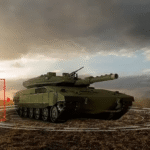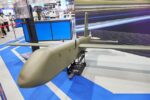Spain has signed a $57 million (EUR 55 million) contract to expand its fleet of Saab Arthur counter-battery radars under a NATO modernization initiative. The deal strengthens Spain’s ground-based surveillance and artillery detection capabilities amid evolving threats from drones and long-range fires.
Arthur Radar: A Proven Battlefield Surveillance Asset
The Saab Arthur (ARTillery HUnting Radar) is a mobile passive electronically scanned array (PESA) radar system designed for counter-battery missions. Operating in the C-band frequency range (4–8 GHz), the system detects incoming artillery rounds—such as rockets, mortars, and shells—and calculates their launch and impact points with high precision. This enables rapid counter-fire or protective measures.
Developed by Sweden’s Saab Electronic Defence Systems (formerly Ericsson Microwave Systems), the Arthur radar has been in service since the early 2000s with over a dozen countries including the UK, South Korea, Norway, Czech Republic, and now an expanded Spanish fleet. The radar is typically mounted on tracked or wheeled vehicles such as the M113 or Bandvagn 206 (Bv206), offering mobility for frontline deployment.
Key specifications of the latest Arthur Mod C variant include:
- Detection range: up to 60 km for rockets; ~40 km for artillery shells
- Target location accuracy: <50 meters CEP
- Simultaneous tracking of multiple projectiles
- High resistance to electronic countermeasures (ECM)
NATO-Funded Modernization Program Targets Artillery and Drone Threats
The new acquisition is part of a broader NATO Communications and Information Agency (NCIA) program aimed at modernizing member states’ ground surveillance capabilities. According to official statements from both Saab and Spain’s Ministry of Defence (Ministerio de Defensa), this contract includes not only new radar units but also upgrades to existing systems in Spanish service.
The funding stems from NATO’s Security Investment Programme (NSIP), which supports shared infrastructure critical to alliance operations. The modernization effort emphasizes enhanced interoperability across allied forces—particularly relevant given increased joint exercises on Europe’s eastern flank since Russia’s full-scale invasion of Ukraine in 2022.
A key focus is improving detection performance against low-flying drones—a growing battlefield threat that traditional radars struggle to track due to small radar cross-sections and slow speeds. While originally designed for artillery spotting, newer iterations of the Arthur system include software-defined enhancements enabling basic Counter-Unmanned Aerial System (C-UAS) functionality.
Spain’s Existing Radar Fleet and Domestic Industry Involvement
Spain has operated Arthur systems since at least 2008 when it procured several units through FMV Sweden as part of its Army’s field artillery modernization. These radars are deployed with Spain’s Brigadas Orgánicas Polivalentes (BOP)—modular brigade units that integrate indirect fire support with ISR assets.
The new contract includes logistics support packages such as spare parts provisioning, software updates, operator training modules, and integration with Spanish command-and-control networks—likely via Indra Sistemas’ national battlefield management systems. While final assembly remains with Saab in Gothenburg or Järfälla facilities in Sweden, subcomponents or sustainment may involve Spanish industry under offset arrangements.
Strategic Implications Amid Rising Fires Threats
The renewed investment in counter-battery radar reflects broader European concerns over long-range fires proliferation—from both conventional tube artillery and rocket systems such as Russia’s Tornado-G/9A52 Smerch or Iran-supplied munitions used by proxy actors.
NATO doctrine increasingly emphasizes “sensor-to-shooter” loops where real-time target acquisition feeds directly into strike platforms like HIMARS or CAESAR howitzers. Systems like Arthur play a critical role here by providing fast geolocation data on enemy firing positions within seconds of launch detection—enabling rapid suppression before adversaries can displace (“shoot-and-scoot”).
This capability also supports force protection by cueing active defense systems or triggering alerts during saturation bombardments—a tactic seen frequently in Ukraine where Russian forces use massed fires against static positions.
Saab’s Growing Footprint in NATO Ground ISR Market
This deal further cements Saab’s position as a key supplier of ground-based surveillance solutions within NATO. Beyond Arthur radars, Saab offers complementary systems like Giraffe AMB—a multi-mission AESA radar capable of simultaneous air surveillance and weapon locating roles—and SR-3 short-range radars tailored for SHORAD/C-UAS missions.
The company has also invested heavily in modular open architecture designs that allow software-defined upgrades without full hardware replacement—an increasingly important requirement amid evolving drone threats. With Sweden now formally joining NATO as of March 2024 following ratification delays by Hungary and Turkey, Swedish defense firms are expected to see increased alignment with alliance procurement frameworks.
Outlook: Interoperability and Future Upgrades
The Spanish-Arthur expansion underscores how legacy sensor platforms can be revitalized through targeted upgrades aligned with alliance-wide needs. As drone swarms proliferate alongside precision-guided munitions on peer-adversary battlefields, demand will rise for agile sensor nodes capable of cueing kinetic/non-kinetic responses across domains.
NATO is likely to continue investing in interoperable ISR nodes like Arthur that can plug into multinational C4ISR architectures via Link-16 or other STANAG-compliant protocols. Future enhancements may include AI-assisted trajectory prediction algorithms or tighter integration with loitering munition targeting cycles—blurring lines between detection asset and shooter node.










